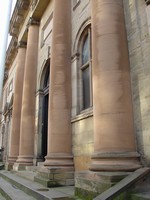|
|
ENGLISH STONE FORUM |
|
.
|
Home
> Issues > Building stone industry in Britain
1
| 2 | 3&4
| 5 | 6
| 7 | 8
| 9 |10
| 11
|
|
|
9.
Today's building sandstone production
The general decline in building sandstone production are probably typified by areas like South Wales and Liverpool. In South Wales good quality sandstone was produced from innumerable small quarries in the sides of the valleys. This Pennant Sandstone from the Coal Measures was used to build the thousands of regimented terraced houses needed to provide homes for the rapidly expanding coal mining industry. Typical of the area are row upon row of blue-grey stone houses with contrasting red or yellow brick coins and door and window mouldings. Each terrace was roofed in blue-grey or purple slates from the quarries of North Wales. Local churches used the same Pennant stone for walling, but to achieve greater decorative effect they commonly used yellow oolitic and shelly limestones from the Middle Jurassic of the Bath area for window and door mouldings. In contrast in Liverpool the terraced housing developments were mainly of red brick, made using mudstones from the local Coal Measure succession and they were until relatively recent times still commonly roofed with North Wales slates. Dimension stone production is today still principally concentrated in the Carboniferous sandstone areas of Northumberland (Black Pasture, Bearl, Blaxter, Doddington), County Durham (Stainton), Tyne & Wear (Springwell), Yorkshire (Bolton Woods, Bramley Fall, Clock Face, Crosland Hill, Greenmoor Rock, Ringby, Woodkirk), Lancashire (Fletcher Bank, Revidge, Waddington Fell, Whitworth), Derbyshire (Birchover, Stanton Moor, Peak Moor, Wattscliffe and Dukes working the Ashover Grit and Stoke Hall working the Kinderscout Grit), South Wales (Blue Pennant, Hafod), the Forest of Dean area (Minetrain, Barnhill, Bixhead) and in Scotland (Binney, Florida). |

Permian Red Mansfield stone Nottingham |
Permian
dolomitic building limestone resources: The Lower magnesian limestone unit
of the Cadeby Formation of Late Permian age forms an almost continuous
outcrop from north Nottinghamshire to the Northumberland coast at Teeside
(Smith 197?). Along much of its length, the outcrop is pock marked by quarries,
many now disused but a few of the larger ones still operating successfully.
The limestone has a mean composition of 54.35% CaC03 and 45.65% Mg C03 (Buist & Ineson 1992), making it a magnesium-rich or dolomitic limestone and has long been quarried for building stone. Some of our most famous historic buildings have been built of this stone. The best known are the cathedral churches of York, Beverley and Southwell, the castle at Conisborough; the abbeys of Thornton, Welbeck, and Roche and the Houses of Parliament in London. In addition the stone has been used in the churches and vernacular housing in many towns and villages of the midlands and north (e.g. Linby, Mansfield, Tadcaster, Wetherby, Thorpe Arch,) and large houses (e.g. Huddleston Hall, Bolsover Castle, Studeley Park) sited along the outcrop. Despite its general uniformity in composition along the length of its outcrop the limestone does show subtle variations in colour and litho logical character. At the southern end of the outrop for example the limestone has a significant component of siliceous sand grains (up to 45%). This sandy facies of the limestone is best developed around the Mansfield area where it has been worked for many centuri~s as a the Mansfield White Stone. The presence of the fine sand grains in the limestone has helped to produced a particularly durable stone which was used extensively in Southwell Minster. |

Penrith sandstone |
The
limestone can vary in colour from white to cream to yellow brown, largely
depending on the proportion of iron present. In the southern part of the
outcrop the Red Mansfield Stone, a dolomitic sandstone, was extensively
quarried and much sought after for decorative building work. The Red Mansfield
is now no longer available and conservation works depends on the substitution
of other red sandstones none of which can be classed as dolomitic. The
Mansfield White Stone also has fine greenish clay seams which provide a
further subtle colour variation to the stone.
In texture the magnesian limestone ranges from rather fine grained lithologies (e.g. Mansfield & Bolsover stones) to hard recrystallized forms with a distinctly coarsely sucrosic texture (e.g. Linby Stone, Bulwell & Steetley stones). In some varieties the original the oolitic, bioclastic or coarsely peloidallimestone fabric is still preserved (e.g. Cadeby, Anston, Roche Abbey and Tadcaster stones). Triassic building stone resources
|
| 1 | 2 | 3&4 | 5 | 6 | 7 | 8 | 9 | 10 | 11 | |
| . |
|